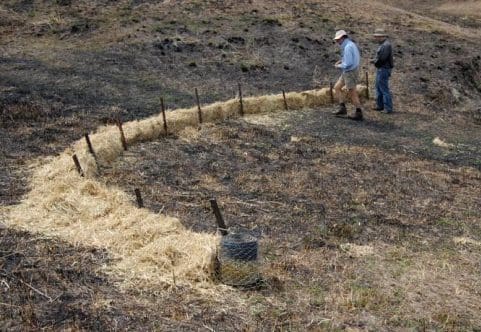
A straw and netting sediment trap erected to mitigate potential erosion after bushfire. Image – Agriculture Victoria
AGRICULTURE Victoria is warning fire-affected landholders in hilly and mountainous areas to prepare for flash flooding, soil erosion and possible landslides before thunderstorms forecast later this week.
Agriculture Victoria Land Management extension officer Clem Sturmfels said flooding, soil erosion and sediment was inevitable in these terrains following a severe bushfire.
These could affect a range of farm assets including tracks, fences, stream crossings, dams, water supplies, buildings and livestock, he said.
The combination of bare ground, water repellent soils, steep slopes and high intensity rainfall can result in significant flooding, soil erosion, landslides and move large quantities of ash, sand, gravel and woody debris downstream.
Woody debris can block dam spillways and stream crossings, flood water can wash away tracks and fences while sediment can pollute or fill dams.
“Previous fire experience in mountainous terrain has shown us floodwater levels in fire-affected areas can be significantly higher than in unburnt landscapes, so landholders should consider implementing measures to protect their farm assets and water supply,” Mr Sturmfels said.
“Constructing sediment traps and levee banks may help protect farm assets from woody debris, ash, sand, and gravel that can block drainage lines, creek beds, bridges, stream crossings and pollute dams.
“The aim is to reduce the velocity of water flow, allowing sediment to drop out rather than be swept into farm dams or streams,” he said.
Sediment traps can be made fairly quickly using wire netting, straw bales or silt fencing material, and should be in place as soon as possible after the fire to prepare properties ahead of the forecasted thunderstorms. Good design and placement is essential for successful results.
Small levee banks can sometimes help protect critical areas from flooding. Levee banks can be made from earth, sand bags, weed free straw bales or corrugated iron sheets and should be well compacted, watertight and have plenty of fall so they don’t become blocked with sediment.
Straw bales and corrugated iron need to be trenched into the ground, tightly butted together and be well supported with steel posts.
A string of closely-spaced steel posts in the drainage line above culverts and stream crossings can be used to trap debris and reduce potential damage.
“Wherever possible, livestock should be moved away from low lying and flood prone areas. Landholders should also divert their down pipes and cover tank inlets to help protect drinking water supplies from roofs contaminated with ash, soil, manure, leaves or firefighting chemicals,” he said.
For more information on land and water management after a bushfire, visit http://agriculture.vic.gov.au/agriculture/emergencies/recovery or call the Agriculture Victoria Customer Service Centre on 136 186.
To stay up to date on emergency conditions, call 1800 226 226 or download the Vic Emergency app.



HAVE YOUR SAY